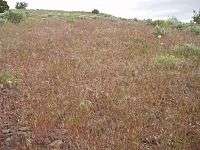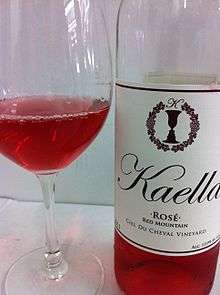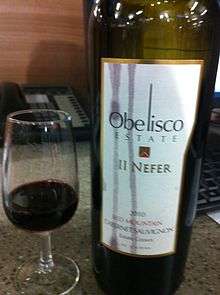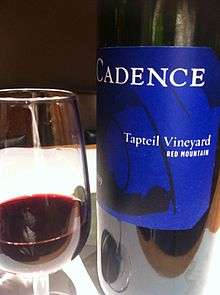Red Mountain AVA
The Red Mountain AVA is an American Viticultural Area that includes the land surrounding Red Mountain in Benton County, Washington. It is part of the Yakima Valley AVA, which in turn is part of the larger Columbia Valley AVA. Located between Benton City and the City of West Richland, the Red Mountain AVA is the smallest in the state at only 4,040 acres (1,630 ha) in area.[4] The area has more than 2,000 acres (810 ha) under cultivation of primarily red varietals including Cabernet Sauvignon, Merlot, Sangiovese, Cabernet Franc and Syrah.[3][5] The reputation of the wines produced in this area has brought Red Mountain AVA worldwide acclaim.[6] The vineyards in this appellation have produced grapes for some of the most sought after wines in Washington State.[2]
| Wine region | |
| Type | American Viticultural Area |
|---|---|
| Year established | 2001[1] |
| Country | United States |
| Part of | Columbia Valley AVA, Washington, Yakima Valley AVA |
| Other regions in Columbia Valley AVA, Washington, Yakima Valley AVA | Rattlesnake Hills AVA, Snipes Mountain AVA |
| Growing season | 180 days |
| Climate region | Continental |
| Precipitation (annual average) | 6 to 8 inches (15 to 20 cm) |
| Total area | 4,040 acres (1,630 ha)[2] |
| Size of planted vineyards | 2,225 acres (900 ha)[3] |
| Grapes produced | Cabernet Franc, Cabernet Sauvignon, Chardonnay, Counoise, Gewurztraminer, Lemberger, Malbec, Merlot, Mourvedre, Nebbiolo, Petit Verdot, Pinot gris, Riesling, Roussanne, Sauvignon blanc, Semillon, Syrah, Viognier[2] |
| No. of wineries | more than 15[3] |
Geography


The Missoula floods, a series of massive floods that occurred at the end of the last Ice Age, profoundly affected the soils of Red Mountain. The fast travelling flood waters, estimated at 390 meters tall, would sweep around the east and west edges of Red Mountain, creating powerfully back-eddies. As a result of the back-eddies, sediments were deposited in an irregular manner, creating a heterogeneous soil with a series of gravel lenses.[7] In the 10,000 years since the Missoula floods, wind-blown loess was deposited, creating a thin mantle of dunes that vary in thickness throughout Red Mountain. This has created a series of soils that differ from those of the immediately surrounding area.
The geography to the northeast features part of the Columbia Basin lowlands where the Columbia River turns southward towards the Saddle Mountains. With elevations ranging from 500 feet (152 m) to 1,500 feet (457 m), the landscape today dominates this area of the lower Yakima Valley. The red color in the name comes from the dark red springtime hue of the drooping brome or "cheatgrass" in the area. The soil in the area is very gravelly, with high alkalinity (high pH) and calcium carbonate content.
Climate
The area has one of the most unusual terroirs in the state with the southwest facing slopes documenting warmer temperatures and more sunlight hours than any other part of the Columbia Valley AVA. The nighttime temperatures drop considerably, helping to preserve the acid levels within the grape.[4] At Benton City, the Yakima River flows past the area and provides a moderating effect on the temperature. Cool air from the north, seeking the lower elevation of the river valley, moves downwards across the hillsides planted with vineyards and helps keep the grapes from being overheated. The constant air movement prevents air from settling in the area and allowing frost to damage the grapes[8]
The area has a desert climate with average yearly rainfall of five inches. During the growing season, daytime temperatures average 90 °F (32 °C) with nighttime temperatures dropping below 50 °F (10 °C).[9] Vineyards rely on irrigation to supply water to their plants, allowing growers to optimize the growth cycle of their grapevines.
History
In the 1970s, John Williams of Kiona Vineyards and Jim Holmes, originally of Kiona then Ciel du Cheval vineyards, pioneered grape growing in the area.[10] In the 1980s, wines made from grapes in the Red Mountain area began receiving recognition for their distinct flavor profiles though federal laws permitted wine labels only to carry the designation as being from the Columbia Valley AVA or Yakima Valley AVA. In the late 1990s, Lorne Jacobson from Hedges Family Estates started a drive to achieve federal recognition of the area as its own AVA, which was granted in April, 2001.[4] Hedges Family Estates' appellation petition was joined by Kiona Vineyards, Blackwood Canyon Vintners, Sandhill Winery, Seth Ryan Winery and Terra Blanca Winery.[9]
In 2007, Chateau Ste Michelle and Marchesi Antinori invested 6.5 million dollars in the appellation to purchase vineyards and establish a winery to produce their joint venture wine, Col Solare.[10]
Wines

The area is known for producing powerful, tannic red wines. The wines are known for their balance in flavors, with an intense concentration of berry flavors.[4] Compared to the Cabernet Sauvignon produced in other areas of the state, the Cabernets here are more structured than fruit-driven.[10] Grapes from this area are in high demand and vineyards with notable reputations can receive as much as 30% above market price for their crops.[8] The primary Cabernet Sauvignon clone planted is clone #8, which in Red Mountain produces a Cabernet wine similar in profile to a California wine, while the same clone planted in nearby Horse Heaven Hills AVA produces a wine similar in profile to Bordeaux.[11]
100 point wines
Many of Washington's cult wines are produced from Cabernet Sauvignon grapes grown in this AVA including the 2002, 2003 and 2005 Quilceda Creek Vintners Cabernet Sauvignon, which scored the rare 100 point wine rating from Robert Parker's The Wine Advocate.[4] At the time, only 15 other wines in the US had received this designation, all made from California grapes.[12] Only five other previous vintages have received consecutive perfect scores in The Wine Advocate's publishing history.[13] The Quilceda Creek wines were blends from three Red Mountain vineyards-Ciel du Cheval, Klipsun, and Tapteil-and one vineyard from the nearby Horse Heaven Hills AVA.[14]
Future growth
In the early 21st century, the reputation of Red Mountain AVA has helped foster an era of growth for the appellation. Like most wine growing regions in Eastern Washington, Red Mountain is in the rain shadow of the Cascade Range. Irrigation is essential to wine growing, with water rights being tightly controlled by Washington's Department of Ecology. In the past, this has limited commercial growth and the opening of new wineries in the area though these restrictions may be lightened in the future. In anticipation of future growth, a committee of local grape growers was formed to promote the development of the area's roads and infrastructure.[10]
Vineyards

- Ciel du Cheval
- Cooper Estate Vineyard
- Klipsun
- Kiona Vineyards
- Obelisco Estate
- Ranch at the End of the Road
- Heart of the Hill
- Tapteil vineyards
- Force Majeure Vineyards (Formerly "Grand Rêve")
- Corvus Vineyard
- Terra Blanca Estate Vineyard
- Artz Vineyard
- Red Mountain Railroad Vineyard
On-Mountain Wineries
- Col Solare Winery
- Cooper Wine Company
- Fidelitas
- Frichette Winery
- Hamilton Cellars
- Hedges Family Estate
- Hightower Cellars
- Kiona Vineyards and Winery
- Monte Scarlatto Estate Winery
- Tapteil Winery
- Terra Blanca
References
- "§ 9.167 Red Mountain" (Title 27: Alcohol, Tobacco and Firearms; Part 9 — American Viticultural Areas; Subpart C — Approved American Viticultural Areas). Code of Federal Regulations. Retrieved January 30, 2008.
- "Red Mountain (AVA): Appellation Profile". Appellation America. 2007. Archived from the original on October 21, 2015. Retrieved January 30, 2008.
- "Red Mountain". Washington Wine Commission. 2018. Retrieved February 14, 2018.
- Parker, Tom (2002). Discovering Washington Wines. Raconteurs Press. pp. 39, 40, 41, 82. ISBN 0-9719258-5-2.
- "Appellations". Washington Wine Center. Archived from the original on March 30, 2007.
- King, Anna (October 9, 2006). "Red Mountain rising: Tiny wine-producing region drawing worldwide attention". Wine Press Northwest. Archived from the original on October 9, 2007.
- Meinart, Lawrence P.; Busaca, Alan J. (December 2002). "Geology and Wine 6. Terroir of the Red Mountain Appellation, Central Washington, U.S.A." (Print). 29 Number 4. GeoScience Canada: 149–168. Cite journal requires
|journal=(help) - Irvine, Ronald; Clore, Walter J. (August 1, 1997). The Wine Project: Washington State's Winemaking History. Sketch Publications. pp. 271, 272. ISBN 0-9650834-9-7.
- Gaffney, Jacob (April 24, 2000). "Washington Wineries Seek New Appellation". Wine Spectator. Archived from the original on September 6, 2004.
- Schoenfeld, Bruce (May 15, 2007). "Gold Rush on Red Mountain". Wine Spectator. Archived from the original on February 7, 2012.
- "Great Grapes: Cabernet Sauvignon: Washington". Wine Spectator. May 15, 2007.
- Allison, Melissa (May 5, 2006). "Cup of cheer overflows for Snohomish vintners". The Seattle Times.
- "Snohomish winery makes state history". The Seattle Times. May 3, 2006. Archived from the original on 2011-05-24.
- "Our Vineyards". Quilceda Creek.